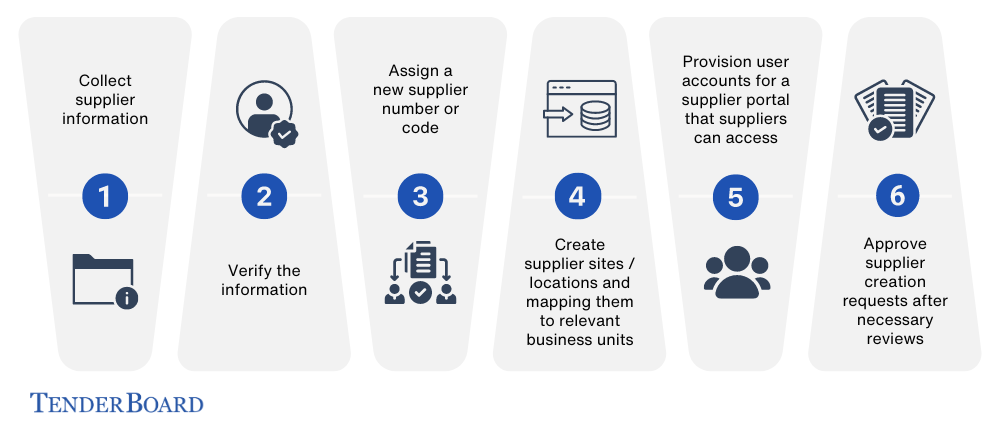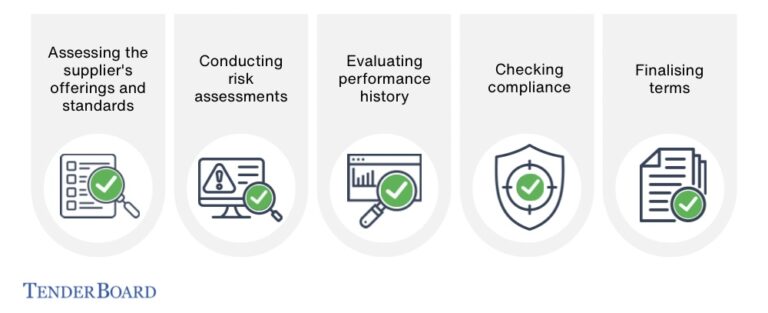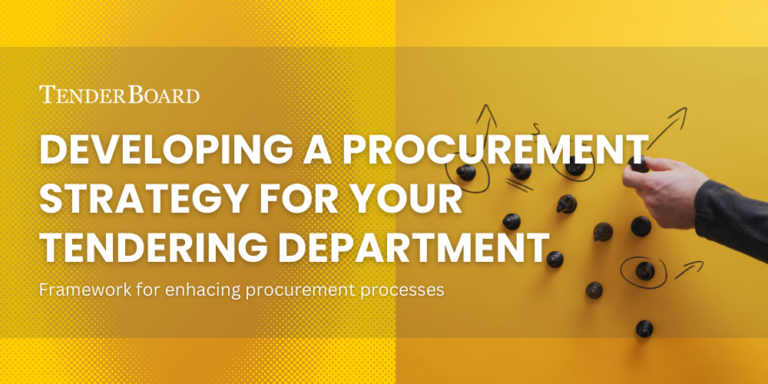Successful supplier management involves multiple processes, from discovering a new supplier to fully integrating them into your business operations. Two fundamental processes are the supplier creation process and the supplier qualification process.
While these stages are part of the broader supplier onboarding and management lifecycle, they serve distinct purposes and require different approaches. Understanding the difference and approaches can help to ensure seamless and efficient supplier onboarding experiences for your organisation and your suppliers.
In this article, we share the steps in the Supplier Creation Process and Supplier Qualification Process, and how TenderBoard eProcurement Platform can help you elevate your supplier management process.
Supplier Creation Process
The supplier creation process is the initial phase of registering a new supplier into the company’s systems and establishing their basic profile information. This step lays the groundwork for all subsequent interactions and transactions. Key activities typically involved in this process includes:

1. Collecting of supplier information
Gathering essential information such as the supplier’s company name, contact information, tax identifiers, and other relevant details that are crucial for maintaining accurate records.
On TenderBoard, our Supplier Management Module allows organisations to easily gather and manage supplier information. Users can trigger vendor forms to be sent to suppliers to complete, along with requests for additional files or documents that suppliers can upload directly to TenderBoard. The supplier’s profile will then be saved and stored on the platform, allowing users to easily retrieve information when needed.
2. Verifying the information
Cross-checking the new supplier’s details with existing records help to prevent redundancy, duplicate entries and maintain data integrity. Preventing duplicate records allows procurement professionals to ensure that all transactions and communications are accurately tracked and attributed to the correct supplier.
3. Assigning a new supplier number or code
Generating a unique supplier identifier, such as a number or code, further streamlines supplier tracking and management. All related supplier information and data can be tagged with the supplier identifier, facilitating efficient communication and record-keeping.
With TenderBoard, companies can set a supplier code to be automatically added when new suppliers are created, eliminating the risk of duplicates and missed codes.
4. Creating supplier sites/locations and mapping them to relevant business units
By creating detailed profiles for each supplier site or location, you ensure that orders, deliveries, and communications are directed accurately. Mapping these sites to relevant business units helps streamline workflows, improves coordination, and ensures that each business unit interacts with the correct supplier locations.
5. Provisioning user accounts for a supplier portal that suppliers can access
By providing user accounts to access a supplier portal, suppliers can securely log in to the portal to manage orders, submit invoices, and communicate with the company. This access streamlines interactions, reduces the risk of miscommunication, and ensures that suppliers have the necessary tools to efficiently collaborate with the company.
TenderBoard makes it easy for suppliers to access and self-help through our Supplier Portal. The platform offers suppliers free accounts to our Supplier Portal, reducing friction and encouraging suppliers to collaborate with you directly on the platform.
6. Approving supplier creation requests after necessary reviews
Reviewing and verifying collected information improves accuracy and ensures compliance with company policies, confirming that the supplier meets all necessary criteria. Once the review is successfully completed, the supplier creation request can be approved, and then the qualified suppliers are onboarded.
Once the vendor forms are filled, TenderBoard automates review and approval routing for supplier creation requests, reducing paper-pushing while ensuring corporate governance. Reminders are sent to stakeholders to reduce bottlenecks, and upon approval, suppliers are automatically onboarded into your vendor lists.
Supplier Qualification Process
In comparison, the supplier qualification process is an evaluation of the supplier’s capabilities, compliance, and suitability to meet the company’s specific requirements.
This process aims to thoroughly vet the supplier to ensure they meet the necessary criteria before being approved to conduct business with the company. Key components of this process include:

1. Assessing The Supplier's Offerings and Standards
This step evaluates the supplier’s product or service offerings, quality standards, relevant certifications etc. It ensures that the supplier aligns with the company’s requirements and standards.
2. Conducting Risk Assessments
Companies can identify potential vulnerabilities by performing financial health checks, site audits and other risk assessments. These assessments help to evaluate the supplier’s ability to fulfil contractual obligations and ensure they comply with operational and regulatory requirements.
3. Evaluating Performance History
Review the supplier’s performance history, references, and customer reviews to assess their track record. This evaluation provides insight into how well the supplier has performed in previous transactions, helping to gauge their ability to meet expectations and deliver consistently.
TenderBoard’s Supplier Management module allows users within the organisation to view a supplier’s track record with the company. Users can also rate or leave feedback of their experience with the supplier, providing better references for other stakeholders to assess the supplier’s value.
4. Checking compliance
Ensuring the supplier adheres to industry regulations, company policies, and ethical codes of conduct helps to safeguard against legal and reputational risks. This process involves verifying that the supplier operates in accordance with applicable laws and regulations, ensuring they maintain ethical standards in their business practices.
With TenderBoard’s Evaluation module, organisations can build compliance criteria checklists to ensure suppliers who are being considered also comply with the company’s corporate policies. Regulation guidelines documents can also be sent to awarded suppliers directly from the system for vendors to review and sign off before commencing on the work.
5. Finalising terms
This step includes negotiating and finalising terms of engagement, pricing structures, and service level agreements. It establishes clear expectations and responsibilities for both parties, and ensures that all parties understand their obligations. This process helps prevent misunderstandings and disputes by laying out the terms of the partnership in a clear and structured manner.
Supplier Creation vs Supplier Qualification
The supplier creation and qualification processes are distinct yet complementary stages in the supplier onboarding lifecycle. The supplier creation process establishes the supplier’s record in the system, while the qualification process rigorously assesses if the supplier is suitable for the intended scope of work or spend categories.
Supplier creation is a prerequisite for engaging with a new supplier, while supplier qualification involves a more thorough evaluation to determine if the supplier meets the organisation’s specific needs and requirements.
Supplier qualification helps organisations mitigate risks, ensure compliance, and select the most suitable suppliers for their procurement needs.
By distinguishing these processes, companies can ensure they have a robust system for onboarding new suppliers while maintaining high standards for supplier performance and compliance.
Leveraging procurement software like TenderBoard can further streamline these processes, ensuring accuracy, efficiency, and compliance every step of the way.













